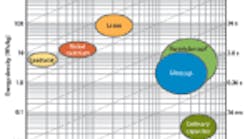FastCAP CEO Riccardo Signorelli, who participated in the MIT research as a doctoral candidate, said that he anticipates power densities of “20 Wh/kg or greater,” if and when the FastCAP Systems capacitors become commercially available. MIT professors John G. Kassakian and Joel E. Shindall oversaw the original research.
The results of the MIT research behind the FastCAP devices were published last November in the Proceedings of the IEEE as “Electrochemical Double-Layer Capacitors Using Carbon Nanotube Electrode Structures.” (Signorelli is the principal author.)The paper can be accessed through MIT’s DSpace repository at hdl.handle.net/1721.1/54729. (All Items in DSpace@MIT are protected by original copyright, with all rights reserved, unless otherwise indicated.)
The hope driving the nanotube research is that electrodes comprising a matrix of vertically aligned carbon nanotubes might provide a combination of high power density and energy density. According to an earlier paper, high power density comes from the nanotubes’ high conductivity. The high energy density is due to the electrochemical properties of carbon nanotubes and to the nanotubes’ uniform vertical alignment.
An interesting tangential section in Signorelli’s 2009 IEEE paper alludes to a problem associated with the irregularity of the jumble of highly divided carbon particles in today’s ultracaps. It notes that today’s ultracaps exhibit multiple time constants associated with their charging and discharging (Fig. 1). As the contemporary ultracap charges in response to a constant current, it exhibits a different rate of charge at various states of charge.
Taken from the IEEE paper, the different lumped time constants in Figure 1 “represent the varying degree of difficulty of ions penetrating the various pore sizes in the activated carbon electrode. That is, the transport of ions into long narrow pores is slower than that of ions into wide shallow pores.” That’s one of the ultracapacitor characteristics that replacing the electrode material with a forest of nanotubes would improve.
In an earlier document on the MIT site, Signorelli and his fellow researchers described the basic manufacturing concept. The idea is that the nanotube forest should be fabricated via chemical vapor deposition of ethylene onto a substrate comprising a “conducting silicon substrate coated with a thin film of alumina” with an iron catalyst.
The nanotubes would assemble themselves in an orderly array, with their growth rate and length controlled by ethylene concentration and growth time. One advantage of growing the active layer “directly on top of the charge collector,” the paper notes, is very low electrode resistance, resulting in even higher power density than in conventional ultracaps.
In the paper, the authors describe the process more fully. They say the low-pressure chemical vapor deposition (LPCVD) process allows the fabrication of multiwall carbon nanotubes (MWNT) on various substrates upon which an iron catalyst has been deposited by electron beam vaporization. The CVD gas mixture comprises acetylene, argon, and hydrogen.
The electrode film the research produced was to have been composed of three-walled nanotubes, each 200 μm long with an average diameter of 6.5 nm, spaced 10 nm apart. (Results varied. Some nanotubes had as many as seven concentric walls, although the average was three.) Those dimensions (Fig. 2) correspond to a nanotube density of 1012/cm2.
After describing the process, the paper analyzes experimental results and values for volumetric and gravimetric energy density characteristics. For potential real-world packaged capacitors, energy density values of 21 Wh/kg and 22 Wh/l were derived for an operating voltage of 2.7 V. However, the authors suggest reasons why operation at 3.5 V might be possible, leading to potential energy densities estimated to be on the order of 35 Wh/kg and 37 Wh/l.
However, note that these are hypothetical estimates by a graduate student extrapolating from experimental results in a scientific paper that includes many conditions and caveats. Speaking as a CEO, Signorelli merely observed that densities of 20 or more Wh/kg might be possible at an undetermined future date.
